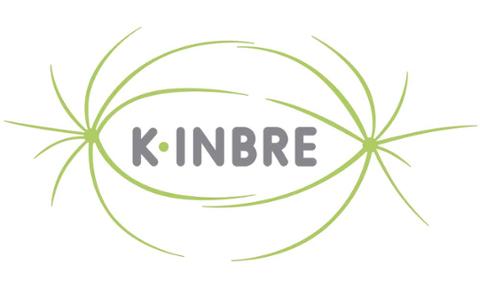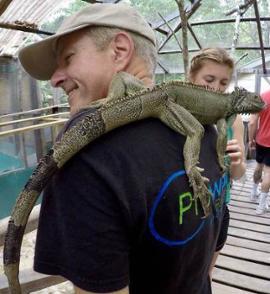K-INBRE
Kansas Idea Network of Biomedical Research Excellence at Pittsburg State University

Pittsburg State faculty and students are involved in a federally-funded effort to enhance biomedical research and training. This website describes the activities of the program on this campus.
The National Center for Research Resources (NCRR) in the National Institutes of Health (NIH) provides Institutional Development Awards (IDeA) to foster research within states that traditionally have not received significant levels of competitive funding from NIH. One of the approaches of the IDeA Program, and the source of support on this campus, was the Biomedical Research Infrastructure Networks (BRIN) now referred to as the Kansas IDeA Network of Biomedical Research Excellence (K-INBRE).
 Pitt State K-INBRE 2025 Symposium attendees
Pitt State K-INBRE 2025 Symposium attendees
The objectives of K-INBRE are to:
- bring together institutions within a state to establish a network,
- provide competitive funding to the state-based network,
- support institutional alterations and renovations,
- provide funding for modern laboratory equipment, and
- assist in the recruitment of new faculty.
K-INBRE funding is also intended to strengthen the basic science departments of the undergraduate institutions in the network by involving students in research. The undergraduate institutions also serve an important "feeder" role to the science departments of graduate schools within the IDeA-eligible areas.
The lead campus for K-INBRE is the University of Kansas Medical Center. Participants in Kansas K-INBRE in addition to Pittsburg State University are Emporia State University, Fort Hays State University, Haskell Indian Nation University, Kansas State University, University of Kansas - Lawrence, Washburn University, and Wichita State University.
Contacts at PSU
Campus Representative (and Faculty Mentor)
- Dr. Anuradha Ghosh, Biology (phone 620.235.4532 | Contact)
- Dr. Paige Boydston, Psychology (phone: 620.235.4279 | Contact)
- Dr. Mike Carper, Health, Human Performance, and Recreation (phone: 620.235.6155 | fax: 620.235.4385 | Contact)
- Dr. Peter Chung, Biology (phone: 620.235.4736 | fax: 620.235.4194 | Contact)
- Dr. Laura Covert-Miller, Health, Human Performance, and Recreation (phone: 620.235.4670 | fax: 620.235.4385 | Contact)
- Dr. Ram Gupta, Chemistry (phone: 620.235.4763 | Contact)
- Dr. Phillip Harries, Biology (phone: 620.235.4864 | fax: 620.235.4194 | Contact)
- Dr. James McAfee, Chemistry (phone: 620.235.4750 | Contact)
- Dr. Jody Neef, Chemistry (phone: 620.235.4494 | Contact)
- Dr. Mandy Peak Bryan, Biology (phone: 620.235.4744 | fax: 620.235.4194 | Contact)
- Dr. Laurent Prétôt, Psychology and Counseling (phone: 620.235.6152 | fax: 620.235.6102 | Contact)
- Dr. Neil Snow, Biology (phone: 620.235.4424 | fax: 620.235.4194 | Contact)
- Dr. Christopher Ward, Biology (phone: 620.235.4741 | Contact)
- Dr. Irene Zegar, Chemistry (phone: 620.235.4903 | Contact)
- Dr. Daniel Zurek, Biology (phone: 620.235.4746 | fax: 620.235.4194 | Contact)
Mailing Address:
Department of Biology [or Department of Chemistry]
Pittsburg State University
1701 S. Broadway
Pittsburg, KS 66762
Faculty Mentors
Each of these faculty guide undergraduate research with support from K-INBRE. But, more than just guiding research, these faculty are active mentors with each student.

My research is focused in two broad areas. First, the ways in which behavioral practitioners are educated and trained in hands-on settings, and how changes to educational or training processes can facilitate stronger applied skill sets. Second, on alterations to discrete portions of therapeutic strategies and techniques in behavioral services, specific to autism spectrum disorder. Current research activities relate to training on diagnostic evaluations and interdisciplinary collaboration, understanding factors impacting the visual analysis of data, increasing intervention service rigor, and evaluating the components of supervision and internship experiences. Interdisciplinary collaboration is welcome, as are undergraduate/graduate students who are interested in autism spectrum disorders or behavior analysis.
Contact Information: phone 620.235.4279 | Contact

Understanding the mechanisms by which tumor cells are resistant to macrophages may lead to the development of therapies which can overcome this resistance. Such a therapy could enhance the effectiveness of macrophages to reduce the occurrences of metastasis and to reject tumors. Our laboratory is currently working with various tumorigenic cell lines to identify the putative gene(s) believed to be responsible for susceptibility to macrophage-mediated cytotoxicity and chemotherapeutic agents.
Contact Information: phone 620.235.4736 | Contact
The overall goal of my research is to improve the health and quality of life for individuals with disabilities and older adults through physical activity. Investigating accurate measures of fitness and health is an additional research area to help improve the reliability and validity of fitness assessments that can be used with such a diverse population. Student research assistants are provided with opportunities to work in the Ability Lab gaining valuable experience with children and adults with disabilities and older adults, specifically individuals with intellectual and developmental disabilities. Research assistants have opportunities to conduct assessments, plan and implement interventions, and evaluate outcomes. Any students who have an interest in this research and the opportunities it can provide are welcome to reach out any time.
Contact Information: phone 620.235.4670 | Contact
Dr. Mazeyar Parvinzadeh Gashti

My lab focuses on the biomedical research interest on synthesis and functionalization of biocomposite particles by biomimetic methods for drug delivery, anticancer, antimicrobial and antifungal applications. Today, we know that biopolymer gels have been extensively used in various areas of biomedicine and pharmacotherapy. Also these gels, as model systems, are also able to change the shape and morphology of particles and tailor their biofunctionality. In biomedical research, functional hybrid particles have been considered in different areas including bone and tissue engineering, surgical instruments and medical devices, neural engineering, cancer therapy, biomechanics, and medical imaging. The investigation of the role of biopolymer-based gels in the synthesis of inorganic particles and crystals is thus important for introducing cost-effective, simple, and convenient strategies in biomedical products.
Contact Information: phone 620.235.4453 | Contact

I am an associate professor in the Department of Biology at Pittsburg state University. I am a microbiologist, and my research is based on the One Health perspective. My projects focus on various aspects of food safety, antibiotic resistance and virulence of food borne pathogens, and molecular diagnostics. A few projects deal with host-pathogen interaction in vectors such as ticks and mosquitoes. I also have projects related to restoration of environmental health. I have introduced whole genome sequence analysis and bioinformatics in the undergraduate curriculum and teaching.
Contact Information: phone 620.235.4532 | Contact
Contact Information: phone 620.235.4763 | Contact
My research background is in Cellular and Molecular Biology as well as Molecular Virology. In recent years I have mentored students who have worked on several diverse projects. These have included examining the effects of polyphenols on cancer cells survival and migration, two bioinformatic-based studies of the relationship between viruses and specific cancers as well as a preliminary studies in synthetic biology aimed at designing a lead biosensor utilizing bacteria.
Contact Information: phone 620.235.4864 | Contact
I am interested in developing biomaterials based on polysaccharides, proteins, and composites, applied as anti-adhesive and antimicrobial agents for bone and cardiovascular implants with hemocompatible activity. I work with surface modification of biomaterials, synthesis of new polymeric materials, and development of biodegradable wound dressings. I study the structure-property relationship of biomaterials and their interactions with bacteria, blood components, and cellular tissues. I focus on scaffolds (hydrogels, fibers, and films) and biomaterial surfaces for regenerative medicine, such as cardiac patches, injectable scaffolds, vascular grafts, and stent coatings.
Contact Information: phone 620.235.4424 | Contact
I am an organic polymer chemist with an extensive knowledge in polymer synthesis and testing. Currently my research is focusing on two areas. The first area is the synthesis of novel aliphatic polyesters containing biologically active molecules. These materials will be tested for antibacterial and antimicrobial properties for potential use in wound dressings or food packaging. The second area is biodegradable polymers. Microplastics are a significant problem in the environment and novel degradable materials are needed to remediate this problem.
Contact Information: phone 620.235.4494 |Contact
Recognition of foreign antigens in the human immune system is primarily performed by the B and T cell receptors. The genes encoding the antigen-binding receptors are produced in a functional form during specific stages of lymphocyte development through a specific DNA rearrangement process referred to as V(D)J recombination. This results in somatic rearrangement of the gene segments that encode the variable regions of B-cell and T-cell receptors. Two lymphoid specific proteins, RAG1 and RAG2, initiate V(D)J recombination by introducing DNA double-strand breaks between each selected gene segment and their bordering recombination signal sequence (RSS) in a two step mechanism, in which the DNA is first nicked followed by hairpin formation. Mutations in either RAG protein that disrupt catalytic activity result in fatal immunodeficiency diseases, including SCID.
Our interests continue at the molecular level and we utilize biochemical methods to further interpret the protein-DNA interactions of RAG1 with the RSS. We will employ photo-crosslinking assays to determine the DNA nucleotides in the RSS heptamer that interact with RAG1 in the presence and absence of RAG2. Overall, these studies will provide important insight into the V(D)J recombination reaction, specifically that significant interaction of the RSS heptamer with RAG1 and to further elucidate the function of RAG1 and RAG2.
Contact Information: phone 620.235.6541 | Contact
My research examines the psychological mechanisms underlying decision-making behavior from both comparative and developmental perspectives. My comparative work explores the influence of species’ ecology on their ability to solve cognitive problems and takes place at Sea Life Kansas City (fishes) and PSU’s Nature Reach (birds). My developmental work uses a game theory approach to investigate the factors influencing children’s cooperative behavior in social dilemmas. More recently, I have taken a leadership position in two newly established Big Team Science networks: ManyFishes, a multi-site collaborative research project dedicated to comparing cognitive and behavioral abilities in fishes, and ManyManys, a large-scale collaboration on comparative cognition and behavior across animal taxa.
Contact Information: phone 620.235.6152 | Contact
Human health is affected significantly by local environmental conditions. Local terrestrial ecosystems and the native fauna they support only function normally in the presence of native species of plants. Surprisingly, many areas have not been adequately surveyed for their native plant diversity, or if so, have not been re-surveyed for many decades. One aspect of my research studies the distribution of native and non-native plants across local landscapes. The data from such studies are needed by state and federal land management agencies, municipal planners, educators, ecologists and other scientists. Environmental consulting, NGOs and with state and federal land-management agencies are good career options.
Contact Information: Phone 620.235.4424 | Contact
Dr. Christopher Ward
Our lab focuses on understanding the complexities of EGFR isoforms in solid tumors, particularly their roles in cancer progression and potential as diagnostic targets. We employ techniques in functional genomics, biostatistics, data science, and next-generation sequencing to identify and characterize isoform-specific behaviors. By combining in vitro assays like transwell migration and spheroid formation with statistical modeling, we aim to uncover novel therapeutic targets and improve diagnostic precision. Students can gain hands-on experience in cell culture and bioinformatics, preparing them for advanced research in cancer biology and biomedical sciences.
Contact Information: Phone 620.235.4741 | Contact
My lab is investigating an antimicrobial protein from soybean as a potential antibiotic. Antibiotic resistance is a rapidly growing problem among human pathogens formerly easily controlled by existing drugs. We cloned a gene from soybean (Glycine max L.) encoding an enzyme possessing glucanase activity, potentially capable of degrading bacterial and fungal cell wall structures, resulting in abatement or termination of microbial growth. It has shown strong activity against several species of gram negative bacteria as well as against Charcoal Rot (Macrophomina phaseolina), a significant fungal pathogen of soybean, corn, cotton, and other crop plants. Analysis of purified recombinant protein from a yeast expression system is underway to determine toxicity of this antimicrobial agent.
Contact Information: phone 620.235.4746 | Contact
PSU K-INBRE Publications
2023
Banerjee, T., Panchal, N., Sutton, C., Elliott, R., Patel, T., Kajal, K., Arogunyo, E., Koti, N., and Santra, S. "Tunable magneto-plasmonic nanosensor for sensitive detection of foodborne pathogens." Biosensors 13:109, 2023.
2022
Choi, J., Morey, K., Kumar, A., Neupane, D., Mishra, S. R., Perez, F., and Gupta, R. K. "Self-assembled cotton-like copper-molybdenum sulfide and phosphide as a bifunctional electrode for green energy storage and production." Materials Today Chemistry 24:100848, 2022.
Panchal, N., Jain, V., Elliott, R., Flint, Z., Worsley, P., Duran, C., Banerjee, T., and Santra, S. 2022. "Plasmon-enhanced bimodal nanosensors: An enzyme-free signal amplification strategy for ultrasensitive detection of pathogens." Analytical Chemistry 94:13968-13977, 2022.
2020
Shaw, Z., Patel, A., Butcher, T., Banerjee, T., Bean, R. and Santra, S. "Pseudo-branched polyester copolymer: an efficient drug delivery system to treat cancer." Biomaterials Science 8:1592-1603, 2020.
2016
Rider, V., Talbott, A., Bhusri, A., Krumsick, Z., Foster, S., Wormington, J. and Kimler, B. “Wingless (WNT) signaling is a progesterone target for rat uterine stromal cell proliferation.” Journal of Endocrinology 229:1-11, 2016.
2013
Ward, J. W., Rider, V., Abdou N. I., and Kimler, B. F. “Estradiol differentially regulates calreticulin: a potential link with abnormal T cell function in systemic lupus erythematosus?” Lupus 22:583-596, 2013.
2012
Weng, Ju-Lin, Samantha L. Young, David M. Gordon, David Claborn, Christine Petersen, Marcelo Ramalho-Ortigao. 2012.First Report of Phlebotomine Sand Flies (Diptera: Psychodidae) in Kansas and Missouri, and a PCR Method to Distinguish Lutzomyia shannoni From Lutzomyia vexator. J. Med. Entomol. 49:1163-1552.
2010
Abdou, N.I., and Rider, V. 2010. "Gender Differences in Autoimmune Diseases: Immune Mechanisms and Clinical Applications": in Principles of Gender Specific Medicine. M. Legato, ed., Elsevier, New York, pp 585-591.
2009
Rider, V., and Abdou, N. I. 2009. "Hormones-Epigenetic Contributors to Gender Biased Autoimmunity". in Epigenetics of Autoimmune Diseases. M. Zouali, ed., John Wiley & Sons Ltd. London, UK, 310-336.
Harries, P.A., Karuppaiah, P., Yu, W., Schoelz, J.E., Nelson, R.S. (2009) The Cauliflower mosaic virus protein P6 forms motile inclusions that traffic along actin microfilaments and stabilize microtubules. Plant Physiology 149(2):1005-1016.
Walters, E., Rider V., Abdou N.I., Greenwell C., Svojanovsky S., Smith P. and Kimler B.F. (2009) Estradiol targets T cell signaling pathways in human systemi lupus. Clinical Immunology 133:428-436.
2008
Gorjestani, S., Rider, V., Kimler, B.F., Greenwell, C., and Abdou, N.I. "Extracellular Signal Regulated Kinase1/2 Signaling in SLE T Cells is Influenced by Estrogen and Disease Activity." Lupus, 17: 548-554, 2008.
Abdou, N. I., Rider, V., Greenwell, C., Li, X. and Kimler B.F. "Fulvestrant (Faslodex) an Estrogen Selective Receptor Downregulator, in Therapy of Females with Systemic Lupus Erythematosus: Clinical, Serologic, Bone Density, and T Cell Activation Marker Studies: A Double-Blind Placebo-Controlled Trial." Journal of Rheumatology, 35: 797- 803, 2008.
Harries, P.A., Karuppaiah, P., Bhat, S., Nelson, R.S. (2008) Tobacco mosaic virus 126-kDa protein increases the susceptibility of Nicotiana tabacum to other viruses and its dosage affects virus-induced gene silencing. Mol. Plant-Microbe Interact. 21:1539-1548.
Harries, P.A., Nelson, R.S. (2008) Movement of Viruses in Plants. Encyclopedia of Virology, 3rd Edition. pp. 348-355. Elsevier Press.
2007
Rider, V., Li, X., and Abdou, N.I. "Hormonal Influences in the Expression of Systemic Lupus Erythematosus." in Systemic Lupus Erythematosus: A Companion to Rheumatology. G. C. Tsokos, P.C. Gordon, J. S. Smolen, eds., Elsevier, New York, NY, 87-94, 2007.
2006
Rider, V., Li, X., Peterson, G., Dawson J., Kimler B.F., and Abdou, N.I. "Differential Expression of Estrogen Receptors in Females with Systemic Lupus Erythematosus". Journal of Rheumatology 33: 1093-1101, 2006.
Li, X., Rider, V., Kimler, B.F., and Abdou, N.I. "Estrogen Does Not Regulate CD154 mRNA Stability in SLE T Cells." Lupus 15: 1-6, 2006.
Rider, V., Isuzugawa, K., Twarog, M., Jones, S., Cameron, B., Imakawa, K., and Fang, J. "Progesterone Initiates Wnt-β-catenin Signaling But Estradiol is Required for Nuclear Activation and Synchronous Proliferation of Rat Uterine Stromal Cells." Journal of Endocrinology 191:1-13, 2006.
Cove, D.J., Bezanilla, M.B., Harries, P.A., Quatrano, R.S. (2006) Mosses as model systems for the study of metabolism and development. Annual Review of Plant Biology, 57, 497-520.
Current Scholars
University Scholars (2024-2025)
| Student Scholar | Mentor |
| Megan Abdilla | Dr. Gashti |
| Sara Akhtar | Dr. Ward |
| Gavin Doubrava | Dr. McAfee |
| Hannah Eckstein | Dr. Harries |
| Noah Freiburger | Dr. Gashti |
| Brett Gibson | Dr. Harries |
| Auditya Jain | Dr. Harries |
| Morgan Leeper | Dr. Pretot |
| Rylan Mason | Dr. Snow |
| Loryn Moser | Dr. Covert-Miller |
| Caitlynn Tate | Dr. Martins |
| Clarissa Wedman | Dr. Brodsky |
Summer/Semester Scholars (2025-2026)
| Student Scholar | Mentor |
| Asher Freiburger | Dr. Gashti |
| Colby Riddle | Dr. Ghosh |
| Debmalyo Rubra Sarma | Dr. Ghosh |
| Gavin Doubrava | Dr. McAfee |
| Hannah Posterick | Dr. Gashti |
| Hannah Warner | Dr. Zegar |
| Lauren Hicks | Dr. Chung |
| Noah Freiburger | Dr. Gashti |
STAR Trainees (2025-2026)
| Student Scholar | Mentor |
| Alexandra Robinson | Dr. Gupta |
| Kelsie Tucker | Dr. Chung |
Data Science Scholar (2025-2026)
| Student Scholar | Mentor |
| Auditya Jain | Dr. Ward |
Past Undergraduate Researchers
Star Trainees
- Ryan Asauskas (Class of 2020) medical school, KUMC
- Jayden Bowen, MD/Ph.D Iowa State
- Kerri Burson, graduate school, Ph.D., Washington University, St. Louis, MO
- Ayushee Dasgupta (Class of 2025) Ph.D. program, KU
- Caine Duran (Class of 2022) working in industry
- Rebekah Elliot (Class of 2018) medical school, KU
- Blaze Heckert, graduate school, OSU
- Vedant Jain, graduate school, Ph.D., KUMC
- Denise Muchangi, applied medical school
- September Numata, graduate school, KUMC
- Christopher Nusbaum, graduate school, University of Pennsylvania
- Sasha Paschchenko, medical school, Dartmouth
-
Carlie Payne (Class of 2024) graduate school, Ph.D., U Texas at Austin
- Danyell Pollard, planned graduate school
- Tyson Roderique, medical school, AT Still
- Rachel Ruiz (Class of 2023) graduate school, University of Alabama
- Tyler Shelby, MD/PhD Yale
- Sarah Veesart, medical school, KU
- Emily Walters, MD/PhD program, Rochester, NY
- Christopher Ward, medical school, KU
- Paul Worsley (Class of 2023) medical scribe, Freeman Health
2022-2025
2025
- Adam Worsley (Class of 2025) graduate school, Wichita State University
- Ayushee Dasgupta (Class of 2025) graduate school, KU
- Caleb Worsley (Class of 2025) high school biology teacher
- Clarissa Wedman (Class of 2025) outcome unknown
- Hannah Eckstein (Class of 2025) medical school, KUMC
- Loryn Moser (Class of 2025) graduate school, PSU
- Samuel Embry (Class of 2025) outcome unknown
2024
- Morgan Blubaugh (Class of 2024) medical school, KUMC
-
Abby Bolick (Class of 2024) biomedical workforce, Kansas City Orthopaedic Institute
-
Brett Gibson (Class of 2024) medical school
-
Jessica Jones (Class of 2024) recreational therapist
-
Morgan Leeper (Class of 2024) AmeriCorps
-
Halle Panter (Class of 2024) graduate school, MS, PSU
-
Shane Rance (Class of 2024) outcome unknown
-
Christopher Simmons (Class of 2024) outcome unknown
-
Zachary Todd (Class of 2024) biotech industry
-
Emma White (Class of 2024) graduate school, MS, OSU
-
Taylor Wixson (Class of 2024) medical school, KUMC
2023
- Delaney Cedeno (Class of 2023) middle school science teacher
- Niamh Dixon (Class of 2023) graduate school, George Washington University
- Zoey Harvey (Class of 2023) graduate school, PSU
- Holly Humes (Class of 2023) US Army
- Kadyn Matlock (Class of 2023) medical school, KUMC
- Taylor Michael (Class of 2023) medical school, KU
- Abby Noble (Class of 2023) pharmacy school, KU
- Madison Reese (Class of 2023) graduate school, OSU
- Rachel Ruiz (Class of 2023) graduate school, University of Alabama
- Marissa Vail (Class of 2023) medical school, KCU
- Paul Worsley (Class of 2023) medical scribe, Freeman Health
2022
- Austin Abram (Class of 2022) environmental consulting
- Shelby Aikins (Class of 2022) graduate school, PSU
- Nicholas Dooley (Class of 2022) working in hospital
- Caine Duran (Class of 2022) biotech industry
- Wes Jameson (Class of 2022) medical school, LSU Health Shreveport Medical School
- Kinsey Morey (Class of 2022) working, Freeman Cancer Institute
- William Niedens (Class of 2022) working, Ascension Via Christi St. Joseph
- Sydney Nippoldt (Class of 2022) working, Labette Health
- Baylie Sigmund (Class of 2022) physical therapy program, KUMC
- David (Adam) Stewart (attended 2022, did not graduate) outcome unknown
2019-2021
2021
- Audriana Angeles (Class of 2021) medical school, KUMC
- Sara Goins (Class of 2021) outcome unknown
- Grace Herren (Class of 2021) physical therapy program, University of Saint Mary
- Vedant Jain (Class of 2021) graduate school, KUMC
- Kyla Jantz (Class of 2021) pharmacy school, University of Colorado Denver
- Monica Jirak (Class of 2021) physician assistant program, Wichita
- Erick McCloskey (Class of 2021) graduate school, KU
- Emma Puddefoot (Class of 2021) outcome unknown
- Morgan Smith (Class of 2021) graduate school, PSU
- Hannah Zerr (Class of 2021) medical school, KUMC
2020
- Ryan Asauskas (Class of 2020) medical school, KUMC
- Halle Brin (Class of 2020) graduate school, PSU; PhD program K-State
- Thai Butcher (Class of 2020) graduate school, PSU
- Brock Crews (Class of 2020) graduate school, UC-Fullerton
- Simon Higginbotham (Class of 2020) medical school, KUMC
- Samantha Knoblauch (Class of 2020) optometry school, St. Louis
- Yashvi Limbasiya (attended 2020, did not graduate) outcome unknown
- Tyson Roderique (Class of 2020) medical school, AT Still
- Drake Shaw (Class of 2020) medical school, AT Still
2019
- Quentin Austin (Class of 2019) outcome unknown
- Nicholas Burnett (Class of 2019) graduate school, MPH
- Mallory Gibson (Class of 2019) medical school, OU
- Robin Goodreau (Class of 2019) manager, pheasant farm
- Benjamin Kelm (Class of 2019) chiropractic school, Cleveland KC
- April Miller (Class of 2019) outcome unknown
- Sarah Veesart (Class of 2019) medical school, KUMC
- Ryan Walker (Class of 2019) graduate program, PSU
- Caleb Winscott (attended Fall 2019, did not graduate) outcome unknown
- Tucker Morey (Class of 2019) medical school, KUMC
- Denise Muchangi (Class of 2019) medical school, KUMC
2016-2018
2018
- Rebekah Elliot (Class of 2018) medical school, KU
- Emily Fry (Class of 2018) medical record specialist
- Garrett Harmon (Class of 2018) PA program MSU, Springfield
- Jonathan Hey (Class of 2018) pharmacy school, KU
- Nathan Kerr (Class of 2018) graduate school, MU
- Abbi Morgan (Class of 2018) graduate school, PSU
- Sasha Pashchenko (Class of 2018) medical school, Dartmouth
- Dakota Robarts (Class of 2018) graduate school, KUMC
- Lok B Shrestha (class of 2018) industry - DuPont
- Erika Sumner (Class of 2018) applied PA program
2017
- Tayita Abudu (Class of 2017) medical school, KU
- Cassidy Barnard (Class of 2017) research tech, University of Iowa
- Karsteen Creech (Class of 2017) working, Mercy Hospital
- Gage Davies (Class of 2017) medical school, KU
- Hannah DeVries (Class of 2017) graduate program
- Miranda Fazzi (Class of 2017) outcome unknown
- Laci Hadorn (Class of 2017) medical school, KCU
- Jessica Jewell (Class of 2017) medical school, KUMC
- Ashley Jimenez (Class 2017) pharmacy school
- Diana Laflin (Class of 2017) medical technology
- Evan Noel (Class of 2017) graduate school, UT Southwestern
- September Numata (Class of 2017) graduate school, KUMC
- Yegor Pashchenko (Class of 2017) medical school, KU
- Megan Peters (Class of 2017) Community Health, medical assistant
- Hannah Thomas (Class of 2017) graduate school, Cornell
- Deaven Thompson (Class of 2017) works in medical office
2016
- Jayden Bowen (Class of 2016) MD/PHD, University of Iowa
- Ashlyn Conner (last attended Spring, 2016) outcome unknown
- Trista Dugan (Class of 2016) medical school, KU
- Tyler Elmore (Class of 2016) medical school, KU
- Rachel Miller (Class 2016) physician assistant program, Wichita
- Maria Newmaster (Class of 2016) medical school, KU
- Lindsey ONeal (Class of 2016) outcome unknown
- Tyler Shelby (Class of 2016) MD/PHD, Yale
- Stephen Stull (Class 2016) outcome unknown
- Kalee Woody (Class 2016) medical school, KCU
- Joshua Yeomans (Class 2016) Continuing Medical Education Coordinator, KUMC
2013-2015
2015
- Sarah Base (Class 2015) working in non-science area
- Trevor Harris (Class 2015) UMKC school of Dentistry
- Mike Noble (Class 2015) medical technology, BMT @ PSU
- Briggs Westby (Class of 2015) medical school, Edward Via, South Carolina
2014
- Boya Abudu (Class of 2014) medical school, San Diego
- Sierra Foster (Class of 2014) medical school, KU
- Austin Price, (Class of 2014) medical school, KU
- Ryan Weir (Class of 2014) medical school, KU
- Christopher Ward (Class of 2014), medical school, KU
2013
- Bradley Aubin (Class 2013) physical therapy program, Washington University, St. Louis
- Erin Blitz (Class of 2013) unknown outcome
- Colton Caldwell (Class 2013) UMKC School of Dentistry
- Bailee Claypool (Class of 2013) Biotech company, Kansas City
- Pamella Connely (Class 2013) graduate school, University of Alaska
- Autumn Gabehart (Class of 2013) Nursing School
- Kurt Herron (Class 2013) medical school, AT Still
- Kelsey Knisley (Class of 2013) physician assistant program
- Myles Taylor (Class of 2013) medical school, KU
- Carly Twarog (Class of 2013) medical school, KU
- Sara Verga (class of 2013) medical school, KU
- Ryan Woodruff (Class of 2013) medical school, KU
- Joshua Wormington (class of 2013) Health Quest technician, Kansas City
- Samantha Young (Class of 2013) graduate school, PSU
2010-2012
2012
- Holly Hrabik (Class of 2012) graduate school, Texas A & M
- Laura Glenn (Class 2012) homeopathic medical school, Springfield, MO
- Megan Kramer (Class of 2012) graduate school, PSU
- Elaine Worth (attended Spring 2012, did not graduate) outcome unknown
2011
- Whitney Baldridge (Class of 2011) graduate school, PSU; PhD program Scripps
- Alissa Becknell (Class of 2011) dental school, UMKC
- Daniel Haines (Class of 2011) medical school, KU
- Elizabeth Kester (Class of 2011) pharmacy school
- Joshua Kristalyn (Class of 2011) outcome unknown
- Zach Krumsick (Class of 2011) medical school, KU
- Joshua Mayfield (Class of 2011) graduate program, University of Texas-Austin
- Megan Miller (Class of 2011) medical school, KU
- Christopher Nusbaum (Class of 2011) graduate school, University Pennsylvania
- Danyell Pollard (Class of 2011) business owner
- Haley Ruther (Class of 2011) graduate school, LSU – Shreveport
- Brett Siegle (Class of 2011) medical school, KU
- Sarah Wolfe (class of 2011) graduate school, University of Texas, Austin
2010
- Caleb Burrows (Class of 2010) medical school, Oklahoma State University
- Afrita Davis (Class of 2010) postbac (Oregon)
- Dustin Graham (Class of 2010) medical school, University of Oklahoma
- Emma Hayes (Class of 2010) graduate school, UMKC
- Amy Pervin (Class of 2010) physician assistant program, Wichita
- Emily Rausch (Class of 2010) medical school, KU
2007-2009
2009
- Elise Johannesen (Class of 2009), medical school, OU
2008
- Rhonda Egidy (Class of 2008) Oak Ridge National Laboratory, Tennessee
- Carrie McDowell (Class of 2008) optometry school, MU-St. Louis
- Kylie Quick (Class of 2008) medical school, KU
2007
- Stacy Jones (Class of 2007) medical school, KU
- Andrew Kleinberg (Class of 2007) medical school, Southwestern, Dallas
- Sara Monrad (Class of 2007) dental school, UMKC
- Chad Stewart (Class of 2008) medical school, KU
- Nolan Williams (Class of 2008) medical school, KU
- Nathan Woodward (Class of 2008) dental school, UMKC
2004-2006
2006
- Brent Cameron (Class of 2006) MD/PhD program, Case Western
- Ryan LaSota (Class of 2006) medical school, KU
- Meryl Twarog (Class of 2006) medical school, Case Western
- John Yost (Class of 2006) medical school, KU
2005
- Scott Grammar (Class of 2005) medical research and development
- James Vallandingham (Class of 2005) graduate school, KU Computer Science/Bioinformatics
- Andrea Wassum (Class of 2005) BsEd, Washburn University
- Rebecca Wolgematt (Class of 2005) medical school, University of Missouri, Columbia, MO
2004
- Andrew Conard (Class of 2004) Graduate Studies, Wesley Theological Seminary, Washington, DC
- Tiffany Dawson (Class of 2004) biotech industry
- Brett Dunbar (Class of 2004) medical school, KCUMB, Kansas City
- Janae Jarred (Class of 2004) medical school, KU
- Ryan Endress (Class of 2004) medical school, KU
- Veronica Casquero Garcia (Class of 2004) graduate school, Universidad de Salamanca, Spain
- Clinton Seifert (Class of 2004) medical school, KU
- Joseph Symes (Class of 2004) chiropractic medicine, Palmer School, Des Moines
- Sarah Yost (Class of 2004) medical school, University of Colorado School of Medicine









